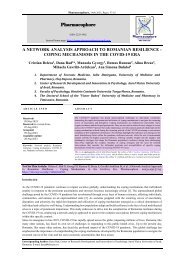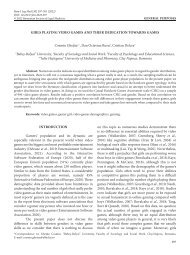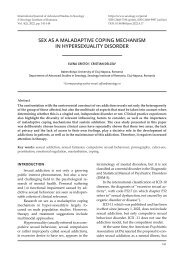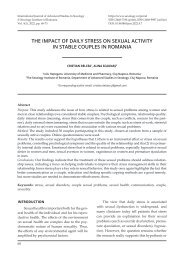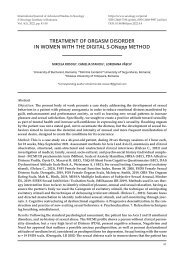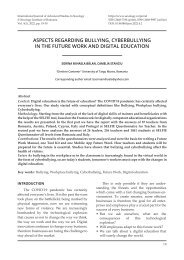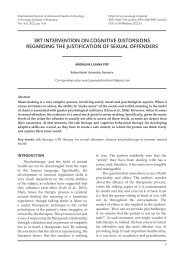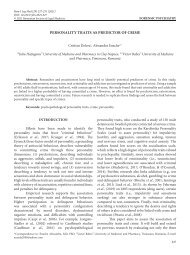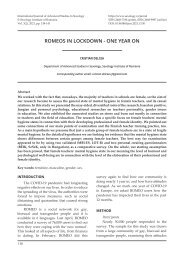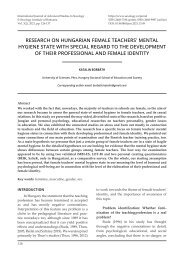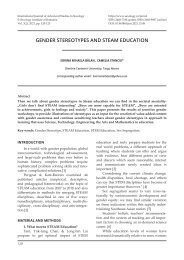Testing the effectiveness of an online CBT intervention with the S-ONapp method for both partners to reduce postpartum female sexual disorders
Objective: The research evaluates the effectiveness of an online CBT program through the S-ONapp method addressed to both partners in order to decrease female sexual problems and increase the sexual satisfaction of both partners in the postpartum period. Method: In a randomized clinical trial, participants - women in the first 3 months postpartum with sexual problems revealed by FSFI scale scores - were randomly assigned to two groups: experimental group (CBT online intervention for both partners) and control group (intervention CBT online standard for women). For both groups, scores on the FSFI (female sexual disorder), NSSS-S (sexual satisfaction) scales for both partners, and DAS (couple satisfaction) scales for both partners are measured on pretest, posttest, and 6-month follow-up. Expected results: Regarding the control group, we expect that in the experimental group there will be: 1) a lower level of postpartum sexual problems reported by women in the posttest; 2) a higher level of sexual satisfaction reported by women in the posttest; 3) a higher level of sexual satisfaction reported by partners in the posttest; 4) a higher level of couple satisfaction reported by women in the posttest; 5) a higher level of couple satisfaction reported by partners in the posttest. The results are maintained 6 months after the intervention. Conclusions: An online CBT intervention program for both partners, based on a multidimensional approach to postpartum female sexual problems, is effective in improving the sexual life of both partners by increasing sexual satisfaction and couple satisfaction, with direct implications for the clinical field.
Objective: The research evaluates the effectiveness of an online CBT program through the S-ONapp
method addressed to both partners in order to decrease female sexual problems and increase the sexual satisfaction of both partners in the postpartum period. Method: In a randomized clinical trial, participants - women in the first 3 months postpartum with sexual problems revealed by FSFI scale scores - were randomly assigned to two groups: experimental group (CBT online intervention for both partners) and control group (intervention CBT online standard for women). For both groups, scores on the FSFI (female sexual disorder), NSSS-S (sexual satisfaction) scales for both partners, and DAS (couple satisfaction) scales for both partners are measured on pretest, posttest, and 6-month follow-up.
Expected results: Regarding the control group, we expect that in the experimental group there will be:
1) a lower level of postpartum sexual problems reported by women in the posttest; 2) a higher level of
sexual satisfaction reported by women in the posttest; 3) a higher level of sexual satisfaction reported
by partners in the posttest; 4) a higher level of couple satisfaction reported by women in the posttest;
5) a higher level of couple satisfaction reported by partners in the posttest. The results are maintained
6 months after the intervention.
Conclusions: An online CBT intervention program for both partners, based on a multidimensional
approach to postpartum female sexual problems, is effective in improving the sexual life of both partners by increasing sexual satisfaction and couple satisfaction, with direct implications for the clinical field.
You also want an ePaper? Increase the reach of your titles
YUMPU automatically turns print PDFs into web optimized ePapers that Google loves.
DELCEA <strong>an</strong>d LERA (DEBUCEAN)<br />
needs, <strong>the</strong> import<strong>an</strong>ce <strong>of</strong> increasing couple satisfaction<br />
<strong>to</strong> solve <strong>sexual</strong> problems <strong>postpartum</strong>.<br />
Overall objective: <strong>to</strong> evaluate <strong>the</strong> <strong>effectiveness</strong><br />
<strong>of</strong> a type <strong>of</strong> <strong>online</strong> <strong>CBT</strong> <strong>intervention</strong> dedicated<br />
<strong>to</strong> <strong>both</strong> <strong>partners</strong> individually in order<br />
<strong>to</strong> <strong>reduce</strong> <strong>postpartum</strong> <strong>female</strong> <strong>sexual</strong> problems<br />
<strong>an</strong>d increase <strong>sexual</strong> satisfaction.<br />
Assumptions: Comparing a <strong>CBT</strong> <strong>online</strong><br />
<strong>intervention</strong> <strong>for</strong> <strong>both</strong> <strong>partners</strong> <strong>with</strong> a st<strong>an</strong>dard<br />
<strong>online</strong> <strong>CBT</strong> <strong>intervention</strong> <strong>for</strong> women, we expect<br />
<strong>the</strong> following results:<br />
1. A lower level <strong>of</strong> <strong>postpartum</strong> <strong>sexual</strong> problems<br />
reported by women in <strong>the</strong> posttest, which is<br />
maintained at 6 months after surgery<br />
2. A higher level <strong>of</strong> <strong>sexual</strong> satisfaction reported<br />
by women in <strong>the</strong> posttest, which is maintained<br />
at 6 months after surgery<br />
3. A higher level <strong>of</strong> <strong>sexual</strong> satisfaction reported<br />
by <strong>partners</strong> in <strong>the</strong> posttest, which is maintained<br />
at 6 months after <strong>the</strong> <strong>intervention</strong><br />
4. A higher level <strong>of</strong> couple satisfaction reported<br />
by women in <strong>the</strong> posttest, which is maintained<br />
at 6 months after <strong>the</strong> <strong>intervention</strong><br />
5. A higher level <strong>of</strong> couple satisfaction reported<br />
by <strong>partners</strong> in <strong>the</strong> posttest, which is maintained<br />
at 6 months after <strong>the</strong> <strong>intervention</strong><br />
METHOD<br />
Design<br />
The research proposes a r<strong>an</strong>domized<br />
clinical trial. The independent variables<br />
m<strong>an</strong>ipulated are <strong>the</strong> type <strong>of</strong> <strong>intervention</strong> <strong>an</strong>d<br />
<strong>the</strong> time at which <strong>the</strong> results are measured.<br />
The independent variable m<strong>an</strong>ipulated in<br />
<strong>the</strong> experiment is <strong>the</strong> type <strong>of</strong> <strong>intervention</strong>, in<br />
two ways: S-<strong>ONapp</strong> <strong>CBT</strong> <strong>online</strong> <strong>intervention</strong><br />
<strong>for</strong> <strong>both</strong> <strong>partners</strong> (experimental group) <strong>an</strong>d<br />
st<strong>an</strong>dard <strong>online</strong> <strong>CBT</strong> <strong>intervention</strong> <strong>for</strong> women<br />
(control group). The independent variable<br />
is <strong>the</strong> time at which <strong>the</strong> measurements are<br />
made: pretest, posttest <strong>an</strong>d 6 months after <strong>the</strong><br />
<strong>intervention</strong> (follow-up). Dependent variables<br />
are represented by: <strong>postpartum</strong> <strong>female</strong> <strong>sexual</strong><br />
problems (H1), <strong>female</strong> couple satisfaction (H2),<br />
partner satisfaction <strong>of</strong> <strong>partners</strong> (H3), <strong>sexual</strong><br />
satisfaction <strong>of</strong> women (H4), <strong>sexual</strong> satisfaction<br />
<strong>of</strong> <strong>partners</strong> (H5).<br />
Particip<strong>an</strong>ts<br />
People who are eligible <strong>for</strong> this study are<br />
women over <strong>the</strong> age <strong>of</strong> 18, in <strong>the</strong> first 3 months<br />
<strong>postpartum</strong>, who have <strong>sexual</strong> dysfunction<br />
(score less th<strong>an</strong> or equal <strong>to</strong> 26 on <strong>the</strong> FSFI<br />
scale), are in a hetero<strong>sexual</strong> relationship, have<br />
a minimum level <strong>of</strong> education, so that <strong>the</strong>y are<br />
able <strong>to</strong> follow <strong>online</strong> programs, have access <strong>to</strong><br />
a computer <strong>an</strong>d <strong>the</strong> Internet. The exclusion criteria<br />
are: following <strong>an</strong>y o<strong>the</strong>r type <strong>of</strong> treatment<br />
<strong>for</strong> <strong>sexual</strong> dysfunction. Women whose partner<br />
refuses <strong>to</strong> participate in <strong>the</strong> study will not be<br />
included.<br />
The power <strong>an</strong>alysis using <strong>the</strong> G * Power<br />
program determined that in order <strong>to</strong> obtain <strong>an</strong><br />
effect d = 0.2 <strong>with</strong> alpha = 0.05, beta = 0.8, 134<br />
particip<strong>an</strong>ts are needed, which me<strong>an</strong>s 67 particip<strong>an</strong>ts<br />
<strong>for</strong> each experimental condition.<br />
Measurement instruments<br />
The Female Sexual Function Index scale,<br />
adapted in Rom<strong>an</strong>i<strong>an</strong>, is used <strong>to</strong> measure <strong>the</strong><br />
level <strong>of</strong> <strong>female</strong> <strong>sexual</strong> <strong>disorders</strong>, which includes<br />
6 dimensions: desire, arousal, lubrication,<br />
orgasm, satisfaction, pain / discom<strong>for</strong>t.<br />
Scores are between 2 <strong>an</strong>d 36 <strong>an</strong>d a score less<br />
th<strong>an</strong> or equal <strong>to</strong> 26 indicates a <strong>sexual</strong> disorder<br />
(Derogatis et al., 2020).<br />
New Sexual Satisfaction Scale - Short Form,<br />
adapted in Rom<strong>an</strong>i<strong>an</strong>, is used <strong>to</strong> measure <strong>the</strong><br />
level <strong>of</strong> <strong>sexual</strong> satisfaction, which includes 2<br />
sub-scales: self-centered (personal habits, perceptions,<br />
emotions) <strong>an</strong>d partner-centered /<br />
<strong>sexual</strong> activity (emotional exch<strong>an</strong>ge <strong>with</strong> partner,<br />
<strong>sexual</strong> frequency). It c<strong>an</strong> be administered<br />
regardless <strong>of</strong> gender or <strong>sexual</strong> orientation. A<br />
higher score indicates a higher level <strong>of</strong> <strong>sexual</strong><br />
satisfaction. (Strizzi et al., 2016).<br />
To measure <strong>the</strong> level <strong>of</strong> satisfaction in<br />
<strong>the</strong> couple, <strong>the</strong> Dyadic Adjustment Scale<br />
adapted in Rom<strong>an</strong>i<strong>an</strong> is used, which includes<br />
four dimensions: couple consensus, couple<br />
satisfaction, couple cohesion <strong>an</strong>d emotional<br />
expression <strong>an</strong>d c<strong>an</strong> be administered <strong>to</strong> <strong>both</strong><br />
<strong>partners</strong> <strong>an</strong>d only one <strong>of</strong> <strong>the</strong>m (Sp<strong>an</strong>ish, 1976).<br />
Working procedure<br />
Recruitment <strong>of</strong> particip<strong>an</strong>ts is done<br />
through <strong>the</strong> <strong>of</strong>fices <strong>of</strong> family doc<strong>to</strong>rs <strong>an</strong>d gy-<br />
78




